Industrial systems depend on reliable fluid control fittings to maintain precise flow, pressure, and direction of liquids and gases under demanding conditions. Without quality fittings, leaks, pressure drops, and equipment failures can halt operations, increase maintenance costs, and compromise safety. This article explains what fluid control fittings are, how they prevent leaks, the benefits of high-performance designs, key applications in the oil and gas and energy industries, selection criteria, maintenance best practices, and where to source trusted solutions from ARPCCO Supply. By understanding these insights, procurement managers and field technicians can enhance system uptime, operational efficiency, and workplace safety.
What Are Fluid Control Fittings and Their Role in Industrial Systems?
Fluid control fittings are mechanical connectors that join pipes, hoses, and valves to manage fluid flow within industrial systems, ensuring leak-free connections and maintaining system integrity under high pressure and temperature. By providing secure seals and accurate alignment, these fittings support continuous operations in hydraulic power units, pipeline networks, and processing equipment. For example, a stainless steel compression fitting links hydraulic hoses in a drilling rig, preventing fluid loss while withstanding 400 Bar of pressure and corrosive environments.
What Types of Fluid Control Fittings Are Commonly Used?
Below is an overview of the main fitting categories and their typical applications in industrial fluid systems.
Entity | Attribute | Value |
Compression Fitting | Connection Method | Threaded or ferrule-based seal |
NPT Adapter | Thread Standard | Tapered NPT threads for pipe systems |
JIC Swivel Fitting | Seal Type | 37° flare metal-to-metal seal |
Flanged Fitting | Mounting | Bolted flange connections for pipelines |
Quick-Disconnect Coupler | Operation | Tool-free coupling for maintenance tasks |
Types of Fluid Control Fittings
Fluid control fittings are categorized based on their application and connection methods, including compression fittings, NPT adapters, JIC swivel fittings, flanged fittings, and quick-disconnect couplers, each designed for specific pressure ratings, fluid types, and installation methods [1, 3]. These fittings are essential for connecting pipes, hoses, and valves to manage fluid flow within industrial systems [1, 3].
Number Analytics, Mastering Fluid Mechanics Fittings (2025)
This research supports the article’s overview of different types of fluid control fittings and their applications.
Each fitting type matches specific pressure ratings, fluid types, and installation methods, guiding technicians to the right component for system requirements.
How Do Fluid Control Fittings Manage Flow, Pressure, and Direction?
Fluid control fittings channel liquids and gases by creating defined passageways, regulating pressure via orifice design, and redirecting flow through elbows or tees. By using precision-machined ports and integrated check valves, they maintain consistent flow rates and prevent backflow. In a chemical processing line, multi-port manifolds distribute reagents evenly, boosting throughput while preserving safety.
Which Materials Are Best for Fluid Control Fittings in Harsh Environments?
Selecting corrosion-resistant materials ensures long-term performance when fluids are acidic, abrasive, or at extreme temperatures.
Entity | Attribute | Value |
Stainless Steel 316 | Corrosion Resistance | Excellent for seawater and acids |
Carbon Steel | Mechanical Strength | High tensile strength at moderate cost |
Brass | Machinability | Good for water and non-corrosive fluids |
Inconel Alloy | Temperature Range | Stable up to 700 °C under pressure |
These material choices prevent degradation and maintain seal integrity during extended service intervals.
How Do Fluid Control Fittings Prevent Leaks and System Failures?
Fluid control fittings use precise tolerances, advanced sealing elements, and robust construction to eliminate pathways for leakage. By integrating O-rings, metal gaskets, and reinforced threads, they sustain pressure boundaries and safeguard system reliability. For instance, 37° JIC fittings employ metal-to-metal seals that improve with pressure, securing connections in hydraulic circuits.
What Design Features Enhance Leak Prevention in Fittings?
Industrial fittings incorporate multiple leak-proof features to reinforce seal integrity:
- Dual O-Ring Seals ensure redundancy by having two elastomeric rings around the connection interface.
- Metal-To-Metal Flare Seals provide direct metal contact that cold-flows under pressure, tightening the seal.
- Back-Up Washers support primary seals and prevent extrusion under high pressures.
- Precision Machining tightens tolerances to micro-inch levels, minimizing gap formation.
These innovations collectively reduce leak risk and extend maintenance intervals.
How Does Proper Installation Impact Fitting Performance?
Correct installation aligns mating surfaces, applies recommended torque, and uses appropriate sealants or tapes. Over-tightening can distort threads, while under-tightening allows gradual seal failure. Field technicians should follow manufacturer torque tables, use calibrated wrenches, and verify alignment with straight-edge tools before pressurizing the system.
What Are Common Causes of Fitting Failures and How to Troubleshoot Them?
Failures often stem from material incompatibility, misalignment, or seal degradation. Troubleshooting follows a systematic inspection:
Entity | Attribute | Value / Action |
Seal Wear | Symptom | Leaking at connection—replace O-rings/gaskets |
Thread Damage | Symptom | Scratches or galling—inspect mating surfaces |
Incorrect Torque | Cause | Check wrench calibration and retorque per specs |
Vibration Fatigue | Cause | Install vibration-resistant fittings or dampeners |
Identifying root causes and applying corrective actions restores system integrity quickly.
What Are the Key Benefits of Using Quality Fluid Control Fittings?
High-quality fittings improve system reliability by maintaining pressure stability, reducing downtime, and lowering maintenance costs. Precision design minimizes flow restrictions and optimizes energy transfer, contributing to overall operational efficiency in pipelines and processing equipment.
How Do Fittings Improve Industrial Efficiency and Reduce Downtime?
Quality fittings streamline fluid paths, minimize pressure drops, and decrease cycle times in hydraulic systems by ensuring consistent flow rates. They also simplify maintenance with quick-disconnect options, reducing system shutdowns for service. As a result, production lines operate continuously, saving labor and energy.
In What Ways Do Fluid Control Fittings Enhance Safety in Industrial Settings?
Safe fluid handling depends on leak-free connections, correct pressure ratings, and resistance to environmental hazards. Premium fittings reduce spill risks, prevent fluid spray in high-pressure lines, and meet industry certifications like ISO 8434 and API 6A. These measures protect personnel and equipment in oil-loaded environments.
How Do Quality Fittings Extend Equipment Lifespan?
Durable materials and robust seal designs resist wear, corrosion, and mechanical stress, which lowers the frequency of component replacement. Fittings that maintain tight seals under fluctuating pressures prevent cavitation damage to pumps and reduce abrasive wear in valves, supporting longer service intervals.
How Are Fluid Control Fittings Applied in Oil and Gas and Energy Sectors?
In the oil and gas and energy industries, fluid control fittings must handle extreme pressures, corrosive media, and high temperatures while ensuring zero downtime. Their role spans wellhead equipment, subsea manifolds, power plant cooling systems, and chemical injection lines.
What Are the Unique Challenges of Fluid Control in Oil and Gas Systems?
Oil and gas operations face abrasive particulates, variable pressures up to 10 000 psi, and exposure to H₂S and chlorides. Fittings must use specialty alloys, incorporate redundant seals, and withstand thermal cycling without leakage or embrittlement to maintain safety offshore and onshore.
How Do Fluid Control Fittings Support Energy Sector Fluid Management?
In power generation, fittings regulate boiler feedwater, steam distribution, and cooling circuits. They promote efficient heat exchange by reducing pressure losses and enable rapid isolation of sections for maintenance. This controlled fluid transfer supports peak power output and system reliability.
What Examples Demonstrate Effective Fitting Use in Harsh Industrial Environments?
- Subsea production trees use duplex stainless steel fittings to resist seawater corrosion under 6000 psi.
- Chemical injection skids feature quick-disconnect couplers for daily maintenance without system depressurization.
- High-temperature refinery units rely on Inconel alloy flanges to maintain seal integrity at 500 °C.
These applications showcase how tailored fittings sustain performance where standard components fail.
How to Select the Right Fluid Control Fittings for Industrial Systems?
Choosing optimal fittings involves evaluating fluid type, operating conditions, and compatibility with existing infrastructure to ensure system resilience and ease of maintenance. By matching material properties, pressure ratings, and connection standards, buyers secure components that deliver long-term value.
What Factors Should Be Considered When Choosing Fitting Materials?
Select materials based on fluid chemistry, temperature range, and mechanical loads:
- Corrosive Fluids: Use stainless steel 316 or nickel alloys to resist pitting.
- High-Temperature Media: Choose Inconel or carbon steel with thermal coatings.
- Abrasion: Opt for hardened steels or ceramic-lined fittings.
Material compatibility prevents premature failure and costly unscheduled shutdowns.
How Do Pressure and Temperature Ratings Influence Fitting Selection?
Below is a comparison of common ratings for hydraulic and process fittings.
Entity | Attribute | Value |
Hydraulic Adapter | Pressure Rating | Up to 6000 psi |
Process Flanged Fitting | Temperature Range | –40 °C to 200 °C |
Inconel Alloy Fitting | Pressure & Temp | 8000 psi at 500 °C |
What Connection Types Are Available and When Should They Be Used?
Industrial systems employ multiple connection standards to suit pressure, maintenance, and integration needs:
- NPT Threads: Economical and common for low-pressure piping.
- SAE 45° Flare: Reliable metal-to-metal seal for hydraulic lines.
- JIC 37° Flare: Preferred for high-pressure hydraulic circuits.
- Flanged Connections: Ideal for large-bore pipelines requiring bolted assembly.
Matching connection type to system demands prevents compatibility issues and simplifies future expansions.
What Are Best Practices for Maintaining and Troubleshooting Fluid Control Fittings?
Regular inspection and proactive part replacement keep fluid systems leak-free and performant. Structured maintenance schedules reduce unexpected failures and support safe operations.
How Can Regular Maintenance Prevent System Downtime?
- Inspect seals and threads monthly for signs of wear or corrosion.
- Apply manufacturer-recommended lubricants to moving couplers.
- Perform pressure-cycle tests quarterly to verify leak integrity.
- Replace O-rings and washers before they reach end-of-life thresholds.
Proactive upkeep stops minor issues from evolving into major system outages.
What Are Common Issues and How to Address Them Quickly?
Entity | Attribute | Action |
Loose Connections | Symptom | Retorque fittings to specified torque |
Seal Extrusion | Symptom | Replace damaged O-rings with correct size |
Corrosion Build-Up | Cause | Clean with compatible solvent and inspect surface |
Thread Galling | Cause | Apply anti-seize compound and realign fittings |
When Is It Time to Replace Fluid Control Fittings?
Fittings should be replaced when seals deform, threads strip, or materials show corrosion pits deeper than 0.1 mm. Scheduled replacement intervals—typically every 3–5 years under standard conditions—ensure that aging components do not compromise safety or performance.
Where Can Industrial Buyers Find Reliable Fluid Control Fittings and Support?
Industrial buyers seeking certified fittings and technical assistance can rely on ARPCCO Supply’s comprehensive product catalog, engineering expertise, and responsive service network. Our offerings meet stringent industry standards and back every sale with dedicated support.
How Does ARPCCO Supply Ensure Quality and Reliability in Fittings?
ARPCCO Supply sources components from certified manufacturers and conducts in-house pressure testing and material analysis to verify performance. Our quality management system aligns with ISO 9001 standards, ensuring each fitting meets specified ratings before shipment. Learn more about our commitment at about ARPCCO Supply.
What Resources Are Available for Selecting and Installing Fittings?
ARPCCO Supply offers detailed installation guides, material selection charts, and technical whitepapers to support procurement managers and technicians. Explore our full product catalog for specification sheets and compatibility matrices that simplify component selection.
How to Contact ARPCCO Supply for Product Inquiries and Quotes?
For custom quotes, technical questions, or expedited orders, contact our sales team directly at contact our sales team. Our engineers are available to help you choose the ideal fittings for your system requirements.
Investing in robust fluid control fittings transforms industrial systems by boosting efficiency, preventing leaks, and extending equipment life. By selecting the right materials, connection types, and maintenance protocols, operators can avoid costly downtime and safety risks. ARPCCO Supply’s expert support and certified products ensure your system runs smoothly under the most demanding conditions. Explore our solutions today to optimize performance and secure long-term reliability.

